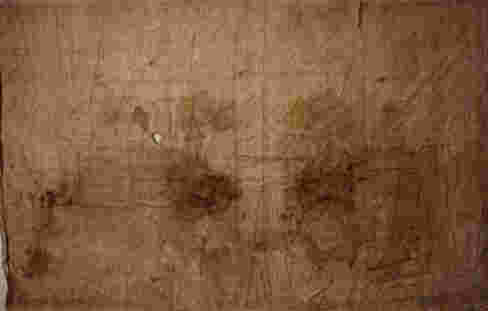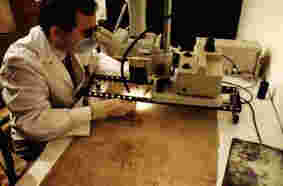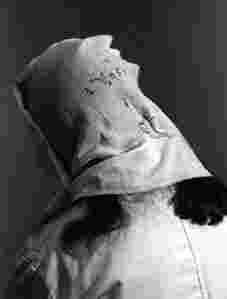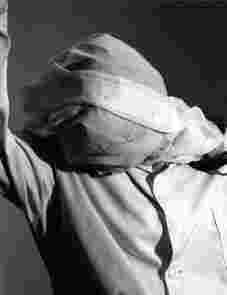
MYSTERIES FROM THE HOLY LAND | ||
|
THE SHROUD OF TURIN:
STARTLING NEWS FROM A STRANGE SOURCE |  THE SUDARIUM OF OVIEDO In the Cathedral of Oviedo (capital of the Principate of Asturias in Spain), a piece of linen cloth has been venerated since the Middle Ages. According to tradition, this piece of linen was placed over the face of Jesus from when he was taken down from the cross until he was buried. The Sudarium of Oviedo was originally white, although now it is dirty, stained and creased. Its texture is taffeta. It is rectangular, somewhat irregular, and measures roughly 83x53 cm (32.37"x20.67"). It has numerous stains of different shades, fundamentally of light brown color. It is traditionally called the "Holy Sudarium" or "Holy Face", in spite of there being no face visible on it. WHAT IS THE TRADITION ABOUT THE SUDARIUM? In the first years of the Christian era, various relics of Jesus and Mary were venerated in Jerusalem. The apostles would have kept these in a cedar chest. These relics had to be saved from the Persian invasion in 614 A.D., headed by Chosroes II [590-628]. They were taken to Alexandria by Philip the presbyter. The Persians also invaded Africa, and the relics were moved again, ending up in Spain. The people who had fled the invasion were received by St. Fulgentius [Visigothic apostle, Ý 630], bishop of Ecija [between Granada and Seville], on their arrival at Cartagena [the oldest Byzantine Diocese in Spain]. He surrendered the chest to his brother and superior, St. Leandro, bishop of Seville. After Leandro, the see of Seville was occupied by St. Isidoro [Ý 636], who was the teacher of St. Ildefonso [Ý 668]. When Ildefonso was appointed bishop of Toledo, he took the chest with him to the capital of the Hispanic-Visigothic kingdom. The Ecclesiastical Dictionary of Spain confirms its presence there at the beginning of the seventh century. In the first half of the eighth century, at the same time as the Moorish invasion [711], a new chest, this time made of oak, left Toledo with the relics and went north to Asturias, some time between 812 and 842 A.D. King Alfonso II the Chaste had a special chapel built for this treasure, initially the chapel of his palace. This chapel, called the "Camara Santa" (Holy Chamber) today forms part of the Gothic cathedral that was built later. From this moment on, the people of Asturias have venerated the so called "Holy Chest" through all its historical vicissitudes. THE SUDARIUM IN OVIEDO It is an undisputed fact that the Sudarium has been in Oviedo for a very long time. The chest was opened in 1075 A.D. when King Alfonso VI visited Oviedo, and an inventory taken of the objects found inside. The King ordered the chest to be covered with silver plating in honour of its content. The year when this was done (1113 A.D.) and a list of the contents can be read on this silver plating. Special mention is made of "the Holy Sudarium of Our Lord Jesus Christ".  From this moment on, there are constant references to the Sudarium in documents, as various inventories were taken. There is nothing to suggest that the relic has ever left Asturias since it was taken there. Spanish people today are not particularly aware of the Sudarium, although this was radically different in the past. It was so well-known in the Middle Ages that in spite of the difficulties in crossing the mountains between Asturias and Castille, many pilgrims on the way to Santiago made a detour to the cathedral of San Salvador in Oviedo to venerate the Holy Chest and its relics. The veneration of the Sudarium has been continuous, as is evident from the rare privilege of giving the Benediction with the Holy Sudarium in the cathedral on certain days of the year; Good Friday, and the eighth jubilee of the Holy Cross. The cloth can only be seen on these occasions. WAS A SUDARIUM USED IN JESUS' BURIAL? In Jesus' time, a sudarium was a piece of cloth (similar to although somewhat larger than a present day handkerchief). It was used like a small towel to clean the sweat off the face or when needed, to wash the face. According to the Universal Jewish Encyclopedia, when the face of a dead body was disfigured or mutilated, it was obligatory to cover it with a veil so that it could not be seen. It was only to be expected that a sudarium (which would have been at hand, sometimes wrapped round the wrist) would be placed over the dead person's face before burial. It is also known that one of the "funeral linens" used in Jewish burials is a sudarium, which covers the face only. The Gospel of St. John twice mentions a sudarium to cover the head of a corpse. In the account of the raising of Lazarus (John 11:44), we are told that Lazarus came out of the tomb with his hands and feet bound and a sudarium wrapped around his head. The most important passage in this aspect, however, is 20:6-7,where a clear distinction is made between the linen in which the body had been wrapped (including, logically, the shroud which is mentioned in the synoptic gospels) and the "cloth which had been over his head". In spite of the fact that in French and Spanish, the Shroud is sometimes called a sudarium, this is an incorrect denomination of the large cloth used to wrap the whole corpse. SCIENTIFIC STUDIES  The first person to study the Sudarium scientifically was Monsignor Giulio Ricci , who mentioned it in the second edition of his book "L'Uomo de la Sindone è Gesù" (1969). The fifth edition of the book contains a much deeper study, which can be summarised in the following three points: - The Shroud and the Sudarium are evangelically compatible. St. John, in chapter XX of his gospel, speaks of both "linen cloths" and a "sudarium". Mgr. Ricci suggests that this latter cloth could have been used to cover the face of Jesus from Golgotha to the tomb, where it was placed to one side. - Geometric study of the stains on the Sudarium. He discovered that there are stains on both sides of the cloth (due to its filtering through). There are two big and practically symmetrical stains, apparently formed by holding the cloth to a bloody face. - The stains on the Sudarium are compatible with those of the face on the Shroud, with numerous details that coincide. At Ricci's suggestion, the well-known pollen expert from Switzerland, Dr. Max Frei, wrote a report after his visit to Oviedo in 1969. He found pollen from six species of plant which were also found on the Shroud, two of them characteristic of Palestine. Other species were identified from North Africa (these are not present on the Shroud), and the absence of species from Turkey and other European countries was also noted. Species from these areas are abundant on the Shroud. In 1985, Dr. Baima Bollone carried out a photographic study of the Sudarium (180 photographs with normal light, and 144 with an infrared film). New samples were taken with adhesive tape, especially from the stained areas, 7 small threads were takenout of the stains and 12 from the edge in order to do a blood test. The result was that the group is AB. In the Congress of Siracusa, Franca Pastore Trosello compared the textile structure of both the Shroud and the Sudarium. She explained that the threads of the two relics are similar in that the thickness of the fibres is identical in each case and both are hand spun with a Z form, but they have been woven differently -the Shroud has a herring bone weave, but the Sudarium is taffeta. THE EDICES IS BORN This was the point when the Spanish Center for Sindonology (C.E.S.) came into being in Valencia, in 1987. Guillermo Heras, a technical engineer was the first to suggest an interdisciplinary study of the Sudarium and was soon after named Head of Scientific Investigation of the C.E.S. The Center was ready and willing to undertake the project. The idea of forming the EDICES (Investigation Team of the C.E.S.) began to take shape. More or less at the same time, Dr. Alan Whanger read a paper at the III International Shroud Congress in Bologna, Italy (May 1989). Using only the photographs published by Ricci, he spoke about the Sudarium and said he had found more than 100 points of coincidence between its stains and those on the Shroud. The special permission to carry out scientific tests on the Holy Sudarium was granted to the C.E.S. in the cathedral chapter meeting at Oviedo on 9th November 1989. Members of our Investigation Teamwere present in Oviedo from 9th to 11th November 1989 and from 16th to 18th February 1990 in order to collect the first data. These first studies were presented at the III National Convention on the Shroud, held in Valencia on 25th March 1990. The first conclusions were presented on an international level at the Shroud Congress held in Cagliari (Sardinia, Italy) on 30th April of the same year. The papers were read by Guillermo Heras, Dr. José-Delfín Villalaín and Jaime Izquierdo. At the III International Scientific Symposium on the Shroud of Turin, held in Rome on 12th June 1993, Dr. Carlo Goldoni confirmed that the blood group of the man whose face the Sudarium covered was AB. In October 1993, some of the most important aspects of the investigation were presented at the II National Congress of Paleopathology held in the Faculty of Medicine in Valencia. The papers on this occassion were read by Guillermo Heras, Dr. José-Delfín Villalaín, Dr. José Antonio Sánchez and Jorge-Manuel Rodríguez. All these scientific studies were presented at the I International Congress on the Sudarium of Oviedo held in Oviedo on 29th, 30th and 31st October 1994. CONCLUSIONS FROM THE FORENSIC STUDY OF THE BLOOD BY THE EDICES 1. The Sudarium of Oviedo is a relic which has been venerated in the cathedral of Oviedo for a very long time. It contains stains formed by human blood of the group AB. 2. The cloth is dirty, creased, torn and burnt in parts, stained and highly contaminated. It does not, however, show signs of fraudulent manipulation. 3. It seems to be a funeral cloth which was probably placed over the head of the corpse of an adult male of normal constitution. 4. The man whose face the Sudarium covered had a beard, moustache and long hair, tied up at the nape of his neck into a pony tail. 5. At the bottom of the back of his head, there is a series of wounds produced in life by short, sharp objects. These wounds had bled about an hour before the cloth was placed on top of them. 6. The man's mouth was closed, his nose was squashed and forced to the right by the pressure of holding the cloth to his face. 7. The man was dead. The mechanism that formed the stains is incompatible with any kind of breathing movement. 8. The man suffered a pulmonary oedema as a consequence of the terminal process. Many stains were made by the fluid from the oedema mixed with blood in a ratio of 6 to 1. These stains were formed consecutively at different moments. 9. The corpse was in a vertical position for about one hour after death ocurred. The right arm was bent upwards and the head 70º forwards and 20º to the right of the vertical position. 10. With no change in the position of the arms, the corpse was placed on its right side, with the head still 20º to the right and 115º from the vertical position. The forehead was leaning on a hard surface. The corpse was in this position for about 45 minutes. 11. The corpse was then moved while somebody's hand tried to stem the flow of liquid from the nose in various positions. 12. The corpse was finally placed lying down with the face up HYPOTHESIS ABOUT HOW THE SUDARIUM WAS POSITIONED Bearing in mind all the above mentioned information, and in accordance with the experiments carried out in the Faculty of Medicine in Madrid, the following hypothesis can be elaborated: The man whose face the Sudarium of Oviedo covered was tortured before he died. He suffered a pulmonary oedema as a result of being hung upright (in a vertical position with the head inclined forward), held up by the arms in such a way that elbows could be bent.  The feet were positioned in such a way that it was very difficult to put his weight on them in order to lift himself up and breathe, but it was, nevertheless, still possible. This means that the feet were not left hanging (in which case death would have come quickly and there would not have been time to generate so much pleural fluid as a result of the efforts to breathe), but they could not be used comfortably as a support as then it would not have been so difficult to breathe. The body was hanging from the arms, with the head inclined forwards onto the chest and to the right, in such a way that the chin was touching the chest and the head plane was parallel to the chest and back, almost horizontal. In this position, the right cheek was almost touching the right shoulder. Shortly after death, the Sudarium was wrapped round the head in the following way: 1) It was positioned beginning at the back of the head, where wounds were caused by sharp objects. The blood from these wounds must have been flowing about an hour before, when the man was still alive, over the existing blood. 2) The cloth was fastened to the long hair in the pony tail, with some sharp objects similar to the present day pins but with a larger diameter. 3) The cloth was then folded round all the left hand side of the face and beard, up to the right hand side. Given the position of the stains, which in turn defines the position of the head, the cloth was then folded back over itself and fastened with the above mentioned sharp objects to the beard. 4) The cloth thus doubled over the face, and the part that was then left over was folded again over the left hand side of the face, held in place by pins or something similar, and finally put over the top of the head. In order to be stable, the right arm must have been lifted up so that the right cheek could almost rest on the right shoulder. If this were not so, the cloth would have been in an unstable and ridiculous position, because it would then have been logical for the head to have been completely wrapped in the cloth, not only its left hand side. 5) The corpse was then laid on its right side for approximately forty five minutes, and then carried face-up. The movement and the fact that the feet were lifted above the level of the nose and mouth caused blood to flow from the latter. Somebody tried to stem the flow by squeezing both nostrils with his left hand over the Sudarium.  6) The corpse was carried to a nearby place (the movement only lasted a few minutes), and the Sudarium was left on the head of the corpse. 7) Finally, the corpse was moved again and then the cloth was taken off the head. It is possible that it was then placed over the enshrouded face again. Translated from Spanish by Mark Guscin (member 0247) | |